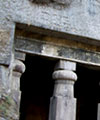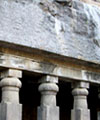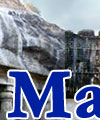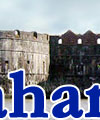| Encyclopedia of Tours and Travel to Maharshtra, featuring information on Fairs & Festivals, Wildlife, Excursion, Adventure and Weather of Maharashtra. |
 |
 |
 |
 |
 |
 |
 |
||
|
Wildlife
Maharashtra is a home to large number of animal and bird species including the tiger, crocodile, bison, gawa, neelgai, wild deer, sambars and rare migratory birds. The government has taken adequate steps towards setting up many wildlife parks and sanctuaries to protect these regions and promote these places as tourist attractions. These parks offer magnificent opportunities to see a wide variety of wildlife in the spectacular natural setting. Modern comforts such as jeep rides, night safaris, library and audio-visual facilities, comfortable accommodation and efficient transport are also available at these parks at a nominal charge. [ Bhamragarh | Bor dam | Chaprala Wildlife Sanctuary | Chikhaldara | Dajipur | Nagzira Wildlife Sanctuary | Navegaon National Park | The Pench National Park | Tadoba National Park | Tipeshwer | Lonar Crater | Nawegaon Bandh ] Bhamragarh The local people in and around the Bhamragarh Wildlife Sanctuary are mostly tribal belonging to the Gond-Madia tribes. They still lead a primitive way of life. The local language is Madia and Gondi. These people are mainly dependent on the forest for their day to day needs such as wood, timber, grass, etc. Other places of interest around the sanctuary is the Hemalkasa Lok Biradari Project run by Dr Prakash Amte. Weather: Winter is from December to February. Followed by summer from March to May. The southwest monsoon season is from June to September, post-monsoon in October and November. The best time to visit is from February to May. Getting there: Nagpur, some 370 km via Chandrapur is the closest airport. The nearest railway station is Ballarpur (on the Delhi-Madras main line) 197 km away. The nearest main bus stations are Aheri (102 km), Ballarpur and Chandrapur (212 kms). Bor dam Weather: There are three seasons, summer, winter and the rainy season. The best time to visit is in April and May. Getting there: Nagpur is the nearest airport, 80 kms away. The nearest bus station is Hingni 5 kms away, while The nearest railway station is Wardha about 35 kms away. Where to Stay: MTDC Resort provides 10 self-contained double-bed rooms, 3 dormitories, and restaurant facilities Reservations MTDC Mumbai, Nagpur Chaprala Wildlife Sanctuary The local people in and around the Chaprala Wildlife Sanctuary are mostly tribals belonging to the Gond community. The local language is Marathi, Telugu, Madia and Gondi. These people are mainly dependent on the forest for their day to day needs such as wood, timber, grass, etc. Other places of other interest around the sanctuary are Prashant Dham at Chaprala, Chaprala Temple and Markanda Temple. Weather: Winter is from December to February, summer from March to May, the monsoon season from June to September and post-monsoon from October and November. Best time to visit is from February to May. Getting there: The nearest airport is Nagpur, 243 kms via Chandrapur. The nearest railway station is Ballarpur (on the Delhi-Madras main line) 70 km away. Chikhaldara It is filled in wildlife -- panthers, sloth bears, sambar, wild boar, and even the rarely seen wild dogs. Close by is the famous Melghat Tiger Project who has 82 tigers. The scenic beauty of Chikhaldara can be enjoyed from Hurricane Point, Prospect Point, and Devi Point. Other interesting excursions include Gavilgad and Narnala Fort, the Pandit Nehru Botanical Gardens, the Tribal Museum and the Semadoh Lake. Weather: Chikhaldara has an annual rainfall of 154 cms. Temperatures vary from 39 C in summer to 5 C in winter. October to June is the best time to visit. Getting there Nearest airport is Nagpur. Nearest railhead is Badnera. Mumbai-Chikhaldara, 763 kms. Nagpur -Chikhaldara, 230 kms. Amravati-Chikhaldara, 100 kms. State transport buses from Amravati and Nagpur to Chikhaldara. MTDC provides you with water-sport facilities at Chikhaldara. Accommodation: MTDC: Self-contained rooms (10 blocks) and Dormitory (1 block for 50 tourists). Privatised: Self contained rooms (20 blocks). Checkout time: 12.00 noon (MTDC) & 8.00 a.m. (privatised). Reservation: Mumbai, Nagpur and Amravati Dajipur It contains bison, wild deer, chital, gawa and many more wild animals and birds. Dajipur is an exciting and beautiful holiday getaway, situated 1200 meters above sea level. This scenic resort near the backwaters of the Radhanagari Dam is highly recommended for wildlife lovers and nature enthusiasts. Getting there Nearest airport is Belgaum. Nearest railhead is Kolhapur on South Central Railway Mumabi-Dajipur, 490 kms. Kolhapur-Dajipur 80 kms. Radhanagari-Dajipur, 30 kms. Phonda-Dajipur, 20 kms. Accommodation: Self-contained rooms, Dormitory (3 blocks, 30 beds) and Tents (seasonal). Restaurant service available. Checkout time: 12.00 noon. Reservation: Information & Reservation Office, Kolhapur. Nagzira Wildlife Sanctuary The sanctuary has a number of fish, 34 species of mammals, 166 species of birds, 36 species of reptiles and four species of amphibians. The fauna includes several species of butterflies and a number of insects and ant species. Nearly 30,000 tourists visits this sanctuary annually. Animals to spot are the tiger, panther, bison, sambar, nilgai, chital, wild boar, sloth bear and wild dog. Other places of interest are Navegaon National Park (50 km), Itiadoh Dam (65 km), Tibetan Camp at Gothangaon (60 km) and Pratapgad (70 km). Timings: October 1 - January 31 -- 7 am to 6 pm. February 1 - June 15 -- 7 am to 7 pm. June 16 - September 30 -- Closed. Weather: For most of the year, temperatures are moderate and pleasant. The best time to visit is during April and May. Getting there: The nearest airport is Nagpur. The nearest bus stand is Sakoli, 22 km away.
Close by rail stations are Nagpur (122 km), Gondia (45 km) and Bhandara (75 km).
Navegaon National Park One can also join the jungle safari and stroll through the beautiful forest, crossing paths with leopards, sloth bears, gaurs, sambars, chitals and langoors. Staying in the unique tree-top house, riding a power or sail boat on the lake, are thrilling pastimes. Nearly 50,000 tourists visits this tourist complex annually. Places of interest around the national park are Nagzira Wildlife Sanctuary (60 km), Itiadoh Dam (20 km), Tibetan Camp at Gothangaon (15 km) and Pratapgad (15 km). Timings: Entry between 7 pm and 4 am hours is prohibited. Weather: Temperatures are pleasant all year round.The best time to visit the national park is during April and May. Getting there: The nearest airport is Nagpur (150 km). The nearest railhead is Deulgaon 2 kms from Navegaon on the Chandrapur-Gondia railway line. The nearest bus stand is Navegaon 10 kms away. The Pench National Park The park gets its name from the Pench River, which maze through it like a mammoth python, dividing it down the center. Pench is an important ecosystem supporting an abundance of flora and fauna, including a rich variety of aquatic lives. The beauty of this part of central India has earned much literary attention. Indeed, the Pench National Park is four different forest regions in one, an overdoing of trees, shrubs, grasses, climbers, weeds and herbs, with teak being the most prominent of the tree species. The park is home to 33 species of mammals, 164 species of birds, 50 species of fish, 10 species of amphibians, 30 species of reptiles, and a wide variety of insect lives. While primarily and reservation for tigers and panthers, Pench is also home to sambhar, chital, barking deer, nilgai, black buck, gaur, wild boar, chausingha, sloth bears, wild dogs, langurs, monkeys, mouse deer, black-naped hares, jackals, foxes, hyenas, porcupines, and flying squirrels, to name a few. Here, birdlife is equally plentiful. The feathered inhabitants of Pench include both resident and migratory birds like Malabar pied hornbills, Indian pittas, ospreys, grey-headed fishing eagles, white-eyed buzzards, storks, waterfowls, four endangered vulture species, and the green pigeon, which is the State Bird. Pench is a naturalist's dreams come true; a mind-expanding experience if ever there is one. Weather: There are three distinct seasons. Summer is from February to middle of June. The monsoon starts from mid-June and lasts till October. Winter starts in October with low temperatures in December/January. Best time to visit is from February to April. Getting there: Nagpur is the nearest airport approximately 70 kms away. Nagpur is the nearest railway station approximately 70 kms away. Ramtek, 35 kms by bus has a regular bus service to Pench National Park. Visiting rules:
Where to Stay: MTDC manages self-contained rooms at Sillari. Reservation: Irrigation Rest House:
MTDC Bookings
MTDC, Tadoba National Park lies in the district of Chandrapur in the northeastern part of Maharashtra, which is often referred to as "The Jewel of Vidharba". It is located in the heart of a reserved forest, it is an infinite treasure of valuable innumerable species of trees and plants - and wildlife that includes tigers, panthers, sloth bears, hyenas, jackals, wild dogs, bison, barking deer, nil gai, sambar, and cheatal. In fact, the Tadoba National Park and Andhari Wildlife Santuary together form the Tadoba-Andhari Tiger Reserve. The park derives its name from "Taru" the local deity, whereas the Andhari river that maze through the forest gives the sanctuary its name. Weather: Winter is from December to February. This is followed by summer from March to May and the monsoon season is from June to September, and the post-monsoon season is from October and November. Best time to visit : February to May. Getting there: The nearest airport is Nagpur (140 km via Umrer, Bhisi and Chimur). The nearest railway station is Chandrapur (on the Delhi-Madras main line) 45 kms away. Nearest main bus stand is Chandrapur and Chimur (32 km). Accommodation: MTDC provides self-contained rooms with adjoining restaurant at Tadoba. Reservations: MTDC at Mumbai and Nagpur. Tipeshwer The following animals are spotted here: the black buck, blue bull, chital, sambar, peacock, hare, snake, monkey, wild boar, bear, wild cat, wolf and jackal. Weather: Temperatures are quite pleasant all around the year, although there are three seasons namely summer, winter and the monsoons. Best time to visit is during April and May. Getting there: Nagpur is the nearest airport around 172 kms. Yavatmal (70kms) and Adilabad in Andhra Pradesh (35 kms) are convenient railheads. The nearest bus station is Pandharkawada 22 kms. Lonar Crater Lonar is distinguished by the fact that it is the world's third largest crater. It has its genesis nearly 50,000 years ago, when a 2 million-ton meteorite impacted the earth to create a depression 1.83 kilometers in diameter and 150 meters deep. Since that cataclysmic event, Lonar has evolved into an idyllic expanse of sky blue water amidst a sprawling emerald forest that stretches around it as far as the eye can see. Today, it attracts casual tourists as well as members of the scientific community from across the world, including research agencies like the Smithsonian Institution of Washington DC, the US Geological Survey, the Geological Society of India, and Sagar University, Jabalpur, and Physical Research Laboratory, Ahmedabad, which have conducted extensive studies about the site. But, the scientific angle aside, this destination also has much to offer wildlife enthusiasts as it is generously endowed in both flora and fauna. The crater is home to hundreds of peafowl, chinkara and gazelles, which browse amongst the shrubs and bushes ringing the lake. Other residents include egrets, moor hens, herons, coots, white-necked storks, lapwings, grey wagtails, grebes, black droungos, green bee-eaters, tailorbirds, magpies and robins - as well as numerous species of migratory birds that often visit the place. Lonar impresses with the richness of its natural heritage. And, like the meteorite that put it on the map, leaves a lasting impression. Where To Stay MTDC Holiday Resort comprises self-contained rooms and dormitory with a restaurant. Getting there: Nearest airport is Aurangabad, 122 kms. Nearest railhead is Malkapur on the Mumbai-Bhusawal line. Mumbai-Aurangabad-jalan-Lonar, 600 kms. Lonar-Buldhana, 95 kms. Lonar-Mehakar Taluka, 23kms. Lonar-Aurangabad, 145 kms. Accommodation: Rest House (2 suites). Reservation: Aurangabad, Pune, Amravati and MTDC Mumbai. Nawegaon Bandh Make sure you visit the deer park, the Dr. Salim Ali Bird Sanctuary, the three beautiful gardens and the children's park. Almost 60% of the bird species found in Maharashtra have been recorded in Nawegaon. Every winter, huge flocks of migratory ducks visit the lake. Sign up for jungle safari and you may see a leopard, sloth bear, gaur, sambar, chital or a languor. Also stay in the unique tree-top retreat. And for more excitement, hire a power or sail boat at the lake. Getting there
Nearest airport is Nagpur, 142 kms.
Nearest railhead is Devalgaon, 1 km. On South Eastern Railway.
Mumbai-Nawegaon, 995 kms.(Mumbai-Nawegaon) Nagpur- Nawegaon, 132 kms. (Nagpur-Bhandara-Sakoli-Nawegaon). Devalgaon- Nawegaon, 1 km.
State Transport buses ply from Bhandara, Nagpur and Devalgaon to Nawegaon
|
||||||||||
|
||||||||||
|
||||||||||
|---|---|---|---|---|---|---|---|---|---|---|